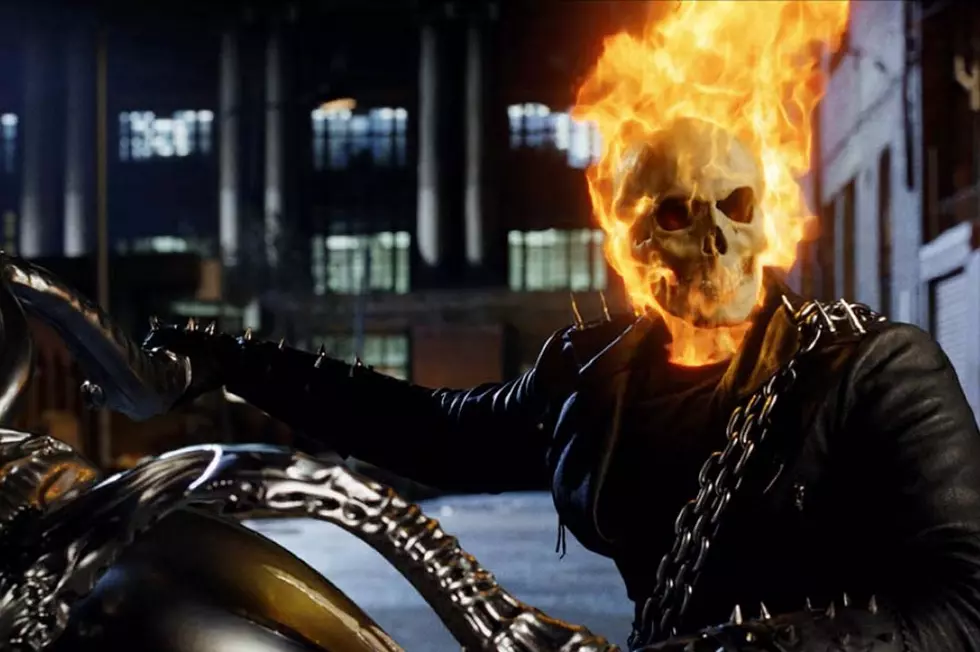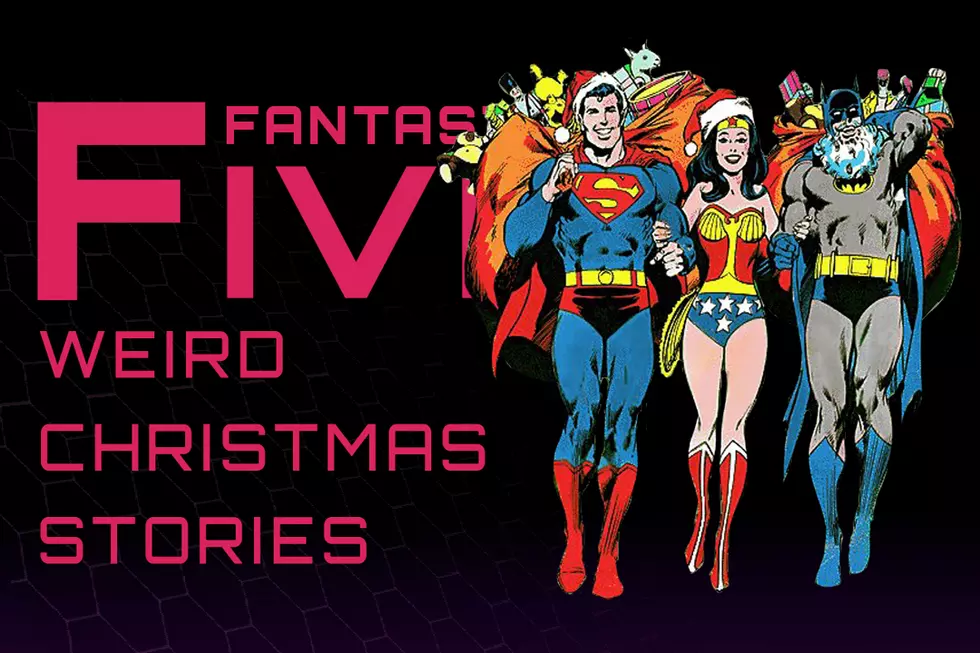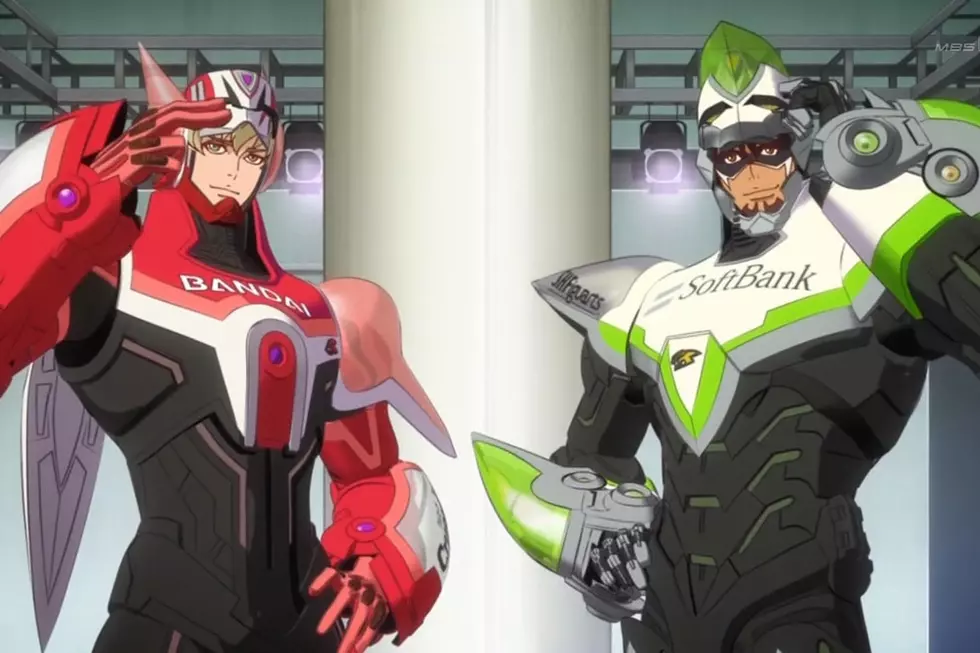![From ‘Peepo Choo’ To ‘Ghost Rider': The Unusually Cool Career Of Felipe Smith [Interview]](http://townsquare.media/site/622/files/2014/08/felipe-smith-hed.jpg?w=980&q=75)
From ‘Peepo Choo’ To ‘Ghost Rider': The Unusually Cool Career Of Felipe Smith [Interview]
Felipe Smith lived the dream of a thousand starry-eyed DeviantArtists when, in 2008, his nerd-skewering masterpiece Peepo Choo debuted at Kodansha-owned manga magazine Morning 2. When asked about what went into accomplishing this feat — becoming fluent in Japanese, keeping pace with the manga industry’s rigorous schedule, being an American noticed by the manga industry at all — Smith is all shrugs and smiles. His work spans the globe, he’s completely reinvigorated Marvel’s Ghost Rider, and, as friends pop by his booth, he slides smoothly in and out of the three languages he speaks, but you know, no biggie. Smith takes it all in his stride.
Peepo Choo, a gleefully lurid tale of cultural fetishization, yakuza, teenage boys, and gravure idols, lies far afield from Ghost Rider in terms of content. But Smith’s zingy, earnest voice unites the two works, and it is this voice that makes Smith such an exciting creator with such a tantalizingly unpredictable future. ComicsAlliance sat down with him at San Diego Comic-Con to discuss living and working in Japan, nerd culture around the world, and what Robbie Reyes brings to the superhero table.

ComicsAlliance: You have a very unique career in comics, having been published in Japan, at Vertical Inc, and now at Marvel with Ghost Rider. How did you get started?
Felipe Smith: I got started by being rejected by pretty much everybody I showed my work to. That's the truth. The work I showed didn't really interest any publishers, it wasn't geared towards kids or a core fan base of a certain genre, like superheroes or adventure or fantasy or anything like that. I wanted to write about real life and personal experiences that I had and I wanted to have a more 'slice of life' approach to my stories, even though they did have action and things that were over the top in terms of action and content. The way I drew characters sometimes would be larger than life -- sometimes literally, depending on the character. I'd draw a twenty-foot character in a regular, normal setting -- but, those things, at the time, the publishers didn't really understand or care for, and it wasn't a style that they had seen or a style that was successful at the time.
So, my biggest response to that was, Well, I've seen comics in Japan and the styles span greatly. It's all different kinds of things are being done story-wise and art-wise, and contrary to the belief at the time that most manga looked like anime, and more specifically the big eye characters and very stylized hair-dos and all those things, there's no real style for manga. It's all across the board. Some of it even looks like American comics, to a degree. Some of it looks like American indie comics. It really opened my eyes to the opportunities within the medium of comics, which is my favorite medium. Drawings and text together is ideal for me, in terms of expressing myself and telling stories, which is something I like to do.
So, I decided to learn Japanese to be able to do this in a market where there were genres readily read by everybody, and produced by publishers. I started teaching myself Japanese while working regular jobs in the service industry -- restaurants and karaoke bars -- and just drew my stuff on the side, then I started entering contests.
The first one, I won, and first place was a trip to Japan, everything -- all expenses paid -- I got to go there for a week and see what it was like. The second one promised a three-book deal to the first place winner; I entered that one and I got second place and I wanted to kill myself because second place was the first place loser.
FS: [But] they actually did give me a three book series, and that's how I started my publishing career. And then after I finished that book, an agent contacted me from Japan and said they were interested in representing me in Japan. I wasn't sure if it was a joke or not; at the time people were saying that I didn't know what I was talking about -- the kind of work that I did was not manga, and it didn't look like anything they considered manga from Japan, and all of a sudden this alleged Japanese agent wanted to represent me, so I answered very politely -- just in case it was real and not somebody cruelly trying to poke fun at me -- and it turned out to be a real person who was interested and who had shown my previous work to the editor in chief at Kodansha. At the time and Kodansha [was] the biggest publisher in Japan.
A year later [in 2008] I was already releasing my first chapter of Peepo Choo in Japan. I moved to Japan that year, and Peepo Choo was serialized for a year and a half. I published 750, did everything -- story, pencils, inks, tones, with the help of one assistant. Because, when you start out a series, you don't have a royalty-based income, so, you're basically paying your page rate to your assistants and you have to make a living as well off of this, so I could only afford that assistant for seven days a month and that was it. Most of the work I was still doing myself, and that's pretty common for a beginning manga artist.

CA: And from Peepo Choo you moved on to animation and Marvel?
FS: I finished [Peepo Choo], did a couple more things, and came back to the states in 2012 and started working in animation on Nickelodeon's Teenage Mutant Ninja Turtles, and I started in the storyboard department and then I moved to character design -- so I'm character designer for season three of the show -- and at the time Marvel Comics approached me and asked me to create a new Ghost Rider for them, which is All New Ghost Rider right now -- an ongoing monthly series -- so I created the character and I'm the writer for the monthly book.
I grew up with the Turtles, so I was nine years old when that cartoon came out and that was it. In college I was still drawing Turtles, it was something I really liked a lot, and then Ghost Rider is one of my favorite characters of the Marvel Universe, because he's an anti-hero, he looks awesome, he's pretty evil, he's -- depending on the depiction -- he could be almost a bad guy, and getting to create a new one for our times right now and for a younger audience -- and especially the fact that he drives a car and doesn't ride a motorcycle -- kind of really opened it up to do different things.
They gave me a lot of freedom in terms of story, and so I made him West Coast-based instead of East Coast like others. ... Robbie Reyes is the protagonist, and he's a high schooler from east LA, with his disabled brother, and he's his sole care taker, and he's a mechanic, and that's how he attempts to pay the bills and take care of his brother, and he's really into muscle cars.
So, one fateful night he borrows a car from the shop he works at to try and win prize money at an illegal street race to try to get out of the neighborhood they live in, which is very dangerous, and they live between two warring gangs and he fears for his brother’s safety. He takes his car and something happens and we witness the birth of an all-new Ghost Rider.

CA: As somebody who grew up with the anime club set, Peepo Choo was very cathartic to read in how it skewered some of the more ridiculous excesses of American anime fandom. I loved how you poked fun at the giant robots vs. spandex cape wars in particular, all those weird nerd pissing matches. Where did that come from? Did it come from a personal place?
FS: I don't read comic books as much and usually what I write, there are things that I don't see that I would like to see. I think of myself maybe as not such an ardent fan of a certain genre or certain kind of character. ... My biggest things have always been to reach out and try to create new audiences for the art form in comics, and that's something that I did see in Japan. I'd see adults that didn't seem to be into any kind of fantasy or super hero [who would] still read something that was comics. It's still something I want to do, I'll still always want to reach other audiences, but I do understand ... people are really into anime and manga and think it's so much better than what they've grown up with here in the States, and I also understand people who are not into it, and the reasons why they don't like them
In the end there's a scene where the two factions at the comic book store argue about which one is better, and really the argument's the same from both sides. They're basically saying the same thing, and I mean, it's very subjective, but, in the end, comics and manga are the same thing, and manga just means comics in a different language.
What people also don't know is that if you go to a bookstore in Japan and you go to the manga section, it doesn't even say "manga," it says "comics." So, the whole discussion that manga comics are different is nonsense, that's what I would say. In terms of work, if it's good it doesn't matter what style it's in, or theme, genre, or what demographic it's aimed towards. If it's a good story and it's solid, something personal, it's got heart to it, it's something different and coming from a definite place, I think the reader will perceive that and be interested, no matter what it's about.
Ghost Rider is the first time I've written a hero story -- but, I approach it like any other story and for me, the most important thing are the characters, because, that's what the reader is going to make a connection with.
Robbie Reyes and who he is, where he lives, how he feels about different things, what his favorite foods are, what places he likes to frequent, what he is passionate about, what he hates, who he cares about, who he despises -- all these things inform the reader as to who this character is. So, when it's time for him to get into the fights or there's peril or there's a chance that he might die, we care about this character, it's not just something where, "Oh, he's a hero and he's probably going to win."
That's kind of what I aim to do and, I mean, regardless of whether it's a love story or an action-super hero story or a slice of life comedy, I approach everything in the same way and I just think that the character is the most important thing. Character is key to any story and I think regardless of the genre or how things are depicted and what the theme is, if it's done with character in mind, I think most readers will be interested, even if they're not into it at first.
CA: You've worked in different genres and different countries. What differences do you notice in audience? What difference do you notice in particular between Japanese readers of Peepo Choo and American readers of Ghost Rider?
FS: I'm very happy about this because I'm not seeing a big difference. One thing about Peepo Choo was that I think I have about half and half readership gender wise. So, both guys and girls read it and they enjoy it and they enjoy it for the same reasons, which makes me very happy.
I think Ghost Rider has a lot of female fans -- I see it on Tumblr, I've got a Tumblr feed and I follow people who dedicate their Tumblr to Ghost Rider and Robbie -- and it makes me really happy and I read everything, their comments about it, and I think that one of my goals is to reach all sorts of audiences, reach as many people as I can and entertain everybody equally.
I think ... a lot of super hero comics have things that I think guys might enjoy more, a lot of the action aspects of things. I'm a sucker for action and over-the-top, sometimes violent things. But I also like the more emotional sides of characters and the more character-driven story lines that have to do with the progression that the character makes from point A to point B, what they learn, how they change, what mistakes they've made and how that's changed, their fate. I try to do a combination of both.
In Japan, the female readership is mostly more interested in that kind of story, about character, and their trials and tribulations, how they learn from the situations that they're put in and how they change as a person. Whereas, guys maybe read more Yakuza stuff, more sports-related things, driving, action, more of that kind of -- maybe a little bit more testosterone-driven, for lack of a better way of explaining it.
But, I enjoy both a lot, and finding a way -- if possible -- to perfectly put them both together is what I would like to do with my story. Sometimes they go one way or the other, they have more of one side of that coin than the other, but I think a good balance to that is a good way to entertain more readers.
I think that's what I learned from looking at the readership in Japan and over here. I think when I talk to them at conventions and they come by to pick up prints or just talk about the stuff they like, I get a sense of what it is that they're enjoying, and I think readers of Ghost Rider and readers of Peepo Choo kind of enjoy the same type of things, regardless if one is black-and-white and two hundred and fifty pages, and the other one is twenty pages a month and is in full color.
So far, so good. I'm happy that people are responding positively to what I'm doing.
CA: What's it like going from being a writer/artist to just being the writer working with a different artist on Ghost Rider?
FS: A learning experience, definitely. Tradd Moore is the artist on the first arc of All-New Ghost Rider. I read his previous work, which is Luther Strode, and already got a feel for the things he seemed to enjoy drawing, which I think we share a lot of those. He's very kinetic, very expressive in both facial and body aspects of storytelling, and he really goes for it and goes over the top for certain things.
Somebody is going to kick through a door, that door is going to be completely decimated, and that's kind of my approach to things too, because it's a comic book, the sky's the limit. As long as you can draw it, you can do it. So, why not really express how broken that door is or how really angry that person is that they're just pouring sweat and their teeth are about to bust because of how hard they're clenching them. That's just something that I think, drawing comics is an art form, and having pictures to illustrate these things, it's a kind of a pity of you don't make use of these things.
So, I think Tradd has those things too; I think he would agree with a lot of this. Working with him is pretty easy in that respect. Once I got a feel for what I thought would be something that he would find exciting to draw, I would write the story to those strengths, and the biggest thing I realize is, when you do write for another artist, which Tradd was the first time for me to do that, you're not writing to your own strengths the way you would actually depict a scene; you're looking at how they convey emotion or time or storytelling in general and then you do it to their strengths.
So, right now, I'm working on the second story arc with Damian Scott, who's an artist who's worked on Spider-Man and Batgirl, and a couple of different series, and he's got a very kinetic, animated style as well, which works great for the kind of story I want to tell. I'm just basically learning to work with people who have different ways of showing a story and conveying emotion and action.
All-New Ghost Rider #1-6 are on sale now in finer comics stores and digitally from ComiXology. Peepo Choo volumes 1-3 are on sale in comics shops and bookstores.
More From ComicsAlliance









